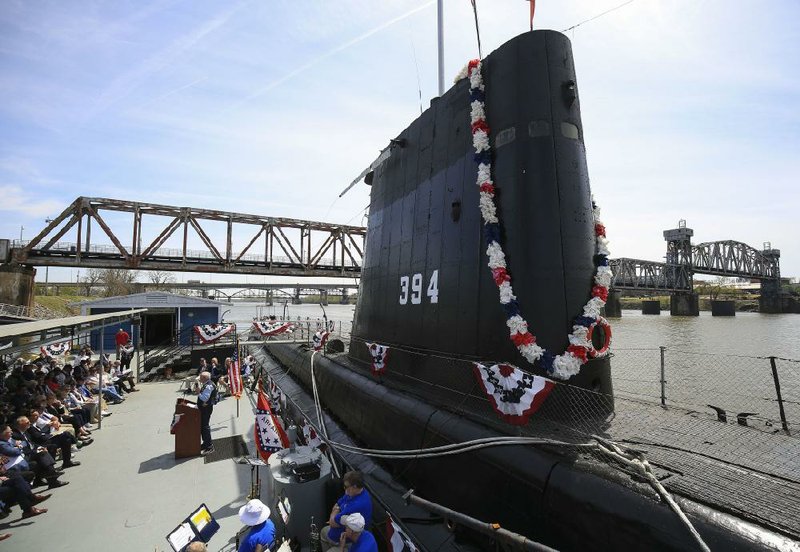Former crew members and sailors who served on submarines were among attendees Wednesday at the Arkansas Inland Maritime Museum in North Little Rock to observe the 75th anniversary of the USS Razorback's commissioning during World War II.
The Razorback went on five combat patrols and rescued downed airmen in the latter years of World War II and was one of 12 submarines present in Tokyo Bay on Sept. 2, 1945, for Japan's formal surrender that ended World War II.
The submarine also ran reconnaissance missions during the Cold War and combat patrols during the Vietnam War before being decommissioned by the Navy in 1970. The Navy then transferred the submarine to the Turkish navy, where it operated until 2001. North Little Rock acquired title to the submarine in 2004 for its museum.
The submarine's 56 years of active duty "makes her the longest-serving submarine today, I believe," said retired Vice Adm. Kenneth E. Floyd, the event's featured speaker, also noting the boat's refurbished condition. "It was, and it is, an incredibly long life. She appears ready to go to sea again."
The observance coincided with this week's USS Razorback Crew Members Association Reunion, attended by 53 former crew members. Submariners from submarine veterans bases in Topeka, Kan., Jefferson City, Mo., and Nashville, Tenn., also joined the festivities this week, said museum Executive Director Greg Zonner.
"They're from all four corners of the country and all points in between," Zonner said.
The submarine and the Pearl Harbor-surviving tug Hoga are the centerpieces of the museum at 120 Riverfront Park Drive. The observance, which featured the North Little Rock Community Concert Band, drew about 150 people. The event was set up for 120, Zonner said, but more chairs had to be brought out and several attendees stood during the 40-minute ceremony.
Floyd, a former commander of the U.S. Third Fleet based in San Diego, has visited the Maritime Museum several times before with his wife, Debbie, "a Conway girl," he told the crowd.
"We love coming back to Arkansas and especially enjoy stopping by to see the museum," said Floyd of Lewisburg, W.Va.
Floyd said he tries to imagine what the lives of submarine crews were like "in this compact, cramped little boat," experiencing "swings in emotions" from the highs of sending a torpedo to sink an enemy ship to the "fear and apprehension" of hearing an enemy boat or aircraft above them sending depth charges and torpedoes at the boat.
"It's hard to imagine living on a submarine for an extended length of time, let alone going into combat as the men of the Razorback did during World War II," Floyd said. "Those were tough times for tough men."
He later ended with a nod to U.S. military members now on duty around the world.
"Many of them are riding that same emotional roller coaster that was found in the Razorback in 1944 and 1945 -- from elation to scared," he said. "Please keep them in your thoughts and prayers."
Charlie Duveen of New York told the story of when the Razorback crew rescued his father, Charles J. Duveen Jr., a navigator and bombardier on a B-29, from enemy waters after his plane was shot down June 5, 1945.
"The crew and the captain make that decision to surface 3 miles off the coast of Japan," Duveen said. "That's a big deal. You can lose your ship in a heartbeat. Yet, they surfaced to pick up downed pilots."
Bob Opple of Seattle, who served on the Razorback 60 years ago, spoke of the submarine's effectiveness and valor of its crews.
"Thirty-five percent of all submarines did not come back," Opple said. "The Razorback always brought her crew home."
Metro on 04/04/2019
